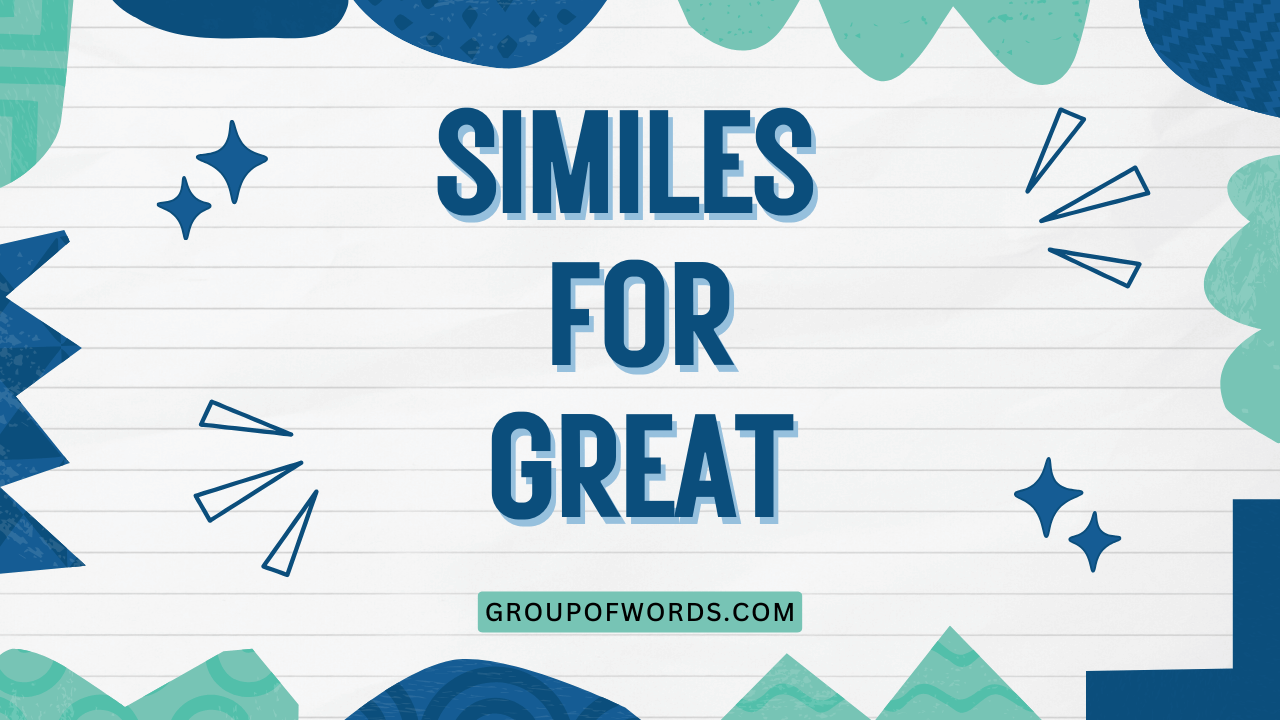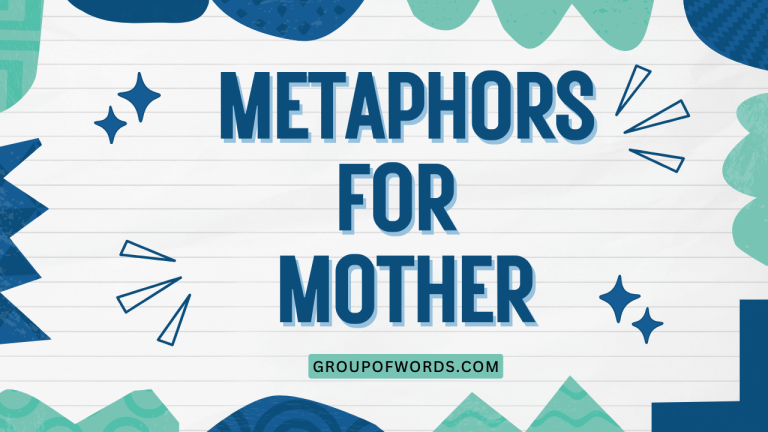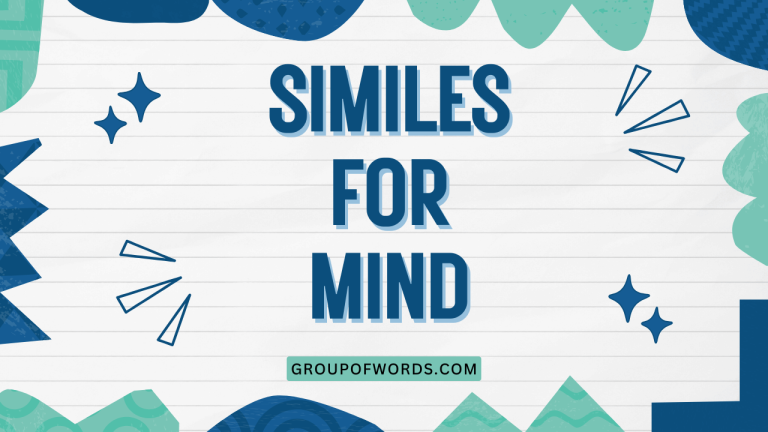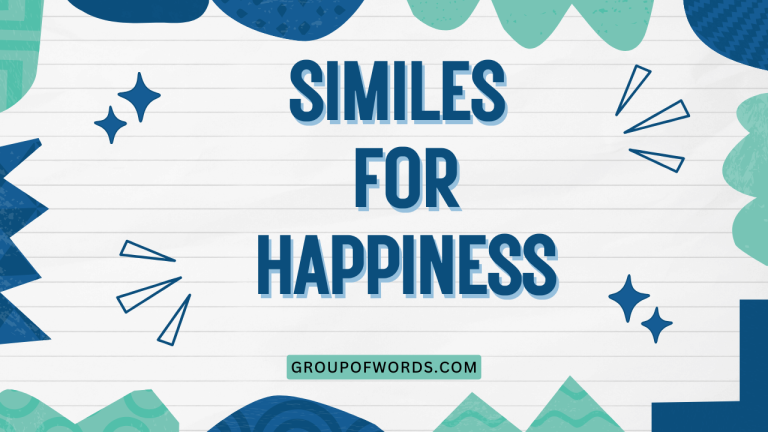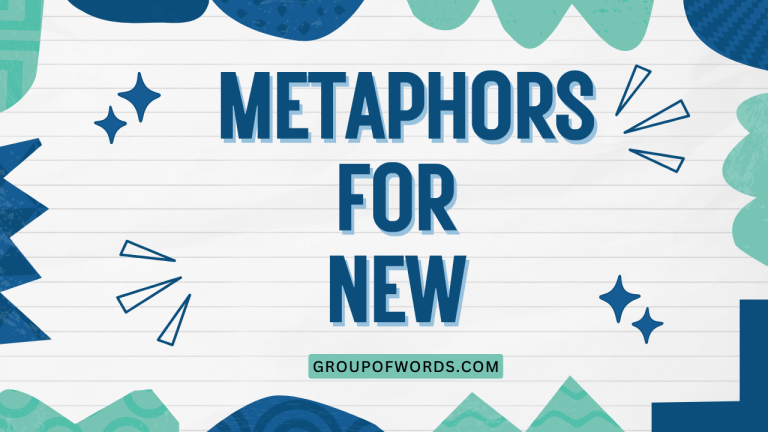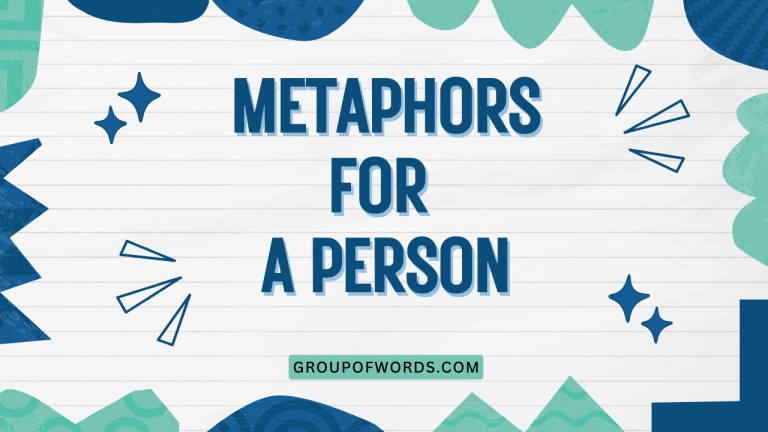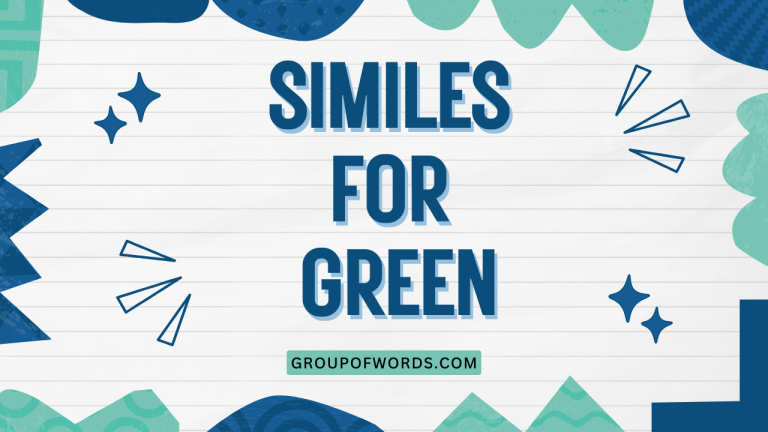Similes for “Great”: Expanding Your Expressive Range
Understanding and using similes is crucial for enriching your writing and speech. Similes, which compare one thing to another using “like” or “as,” add depth and vividness to descriptions.
When you want to express that something is “great,” relying solely on that word can become monotonous. Exploring various similes allows you to convey the magnitude, quality, or impact of greatness in a more engaging and imaginative way.
This article will guide you through numerous similes for “great,” providing examples and exercises to enhance your command of the English language. This guide will benefit English language learners, writers, and anyone seeking to improve their descriptive abilities.
Table of Contents
- Introduction
- Definition of a Simile
- Structural Breakdown of Similes
- Types of Greatness and Corresponding Similes
- Examples of Similes for “Great”
- Usage Rules for Similes
- Common Mistakes with Similes
- Practice Exercises
- Advanced Topics in Simile Usage
- Frequently Asked Questions
- Conclusion
Definition of a Simile
A simile is a figure of speech that compares two unlike things, typically using the words “like” or “as.” The purpose of a simile is to create a vivid image or convey a particular quality by associating the subject with something more familiar or evocative. Similes are essential tools in descriptive writing and speech, allowing for more nuanced and impactful communication.
They help to make abstract concepts more concrete and relatable.
In essence, a simile draws a parallel between two distinct entities, highlighting a shared characteristic. This comparison enhances understanding and adds a layer of artistry to language.
Unlike metaphors, which directly equate two things, similes acknowledge the difference while emphasizing a similarity. This distinction is crucial in maintaining clarity and precision in expression.
Structural Breakdown of Similes
The basic structure of a simile consists of three key elements: the subject, the comparative word (“like” or “as”), and the object of comparison. The subject is the thing being described.
The comparative word establishes the connection. The object of comparison provides the basis for the comparison.
For example, in the simile “He is as strong as an ox,” “he” is the subject, “as” is the comparative word, and “an ox” is the object of comparison. This structure clearly indicates that the subject possesses a quality (strength) similar to that of an ox.
Understanding this structure allows for the creation of effective and meaningful similes.
Variations in sentence structure can also be used to create similes. You can find similes that are embedded within a larger sentence, or which rely on implied comparisons.
The core elements, however, remain the same: the subject, the comparison, and the object.
Types of Greatness and Corresponding Similes
The concept of “greatness” is multifaceted, encompassing various qualities and attributes. To effectively use similes, it’s important to consider the specific type of greatness you wish to convey.
Here are several categories:
- Size and Magnitude: Emphasizes the physical or numerical extent of something.
- Quality and Excellence: Highlights the superior nature or standard of something.
- Impact and Influence: Focuses on the effect or power something has on others.
- Importance and Significance: Underscores the value or relevance of something.
- Skill and Ability: Showcases exceptional talent or competence.
By identifying the specific type of greatness, you can choose similes that are more precise and impactful. This categorization allows for a more nuanced and sophisticated use of language.
Examples of Similes for “Great”
The following sections provide examples of similes categorized by the type of greatness they convey. Each category includes a table with numerous examples to illustrate the range and versatility of simile usage.
Similes for Great Size and Magnitude
When you want to emphasize the immense size or scale of something, these similes can be particularly effective. They often invoke images of vastness and grandeur.
The following table contains examples of similes that describe something as being impressively large or of great magnitude. Note how each simile uses different imagery to convey a sense of immensity.
| Simile | Explanation |
|---|---|
| As big as an elephant | Implies a very large size, like that of a huge animal. |
| As vast as the ocean | Suggests an immeasurable expanse. |
| As tall as a skyscraper | Conveys great vertical height. |
| As wide as a football field | Indicates considerable horizontal width. |
| As massive as a mountain | Emphasizes great bulk and weight. |
| As expansive as the desert | Highlights a large, open area. |
| As immense as the universe | Suggests limitless size. |
| As colossal as a statue of liberty | Implies a massive and imposing presence. |
| As gigantic as a blue whale | Compares to the largest animal on Earth. |
| As enormous as a stadium | Indicates a very large enclosed space. |
| As voluminous as a library | Suggests a large quantity or capacity. |
| As substantial as a fortress | Emphasizes solidity and size. |
| As considerable as a continent | Indicates a significant landmass. |
| As broad as a river | Conveys considerable width. |
| As weighty as a ton of bricks | Implies a heavy and substantial amount. |
| As lengthy as a marathon | Suggests a long duration or distance. |
| As ample as a harvest | Indicates a plentiful or abundant quantity. |
| As sweeping as a panorama | Emphasizes a wide and comprehensive view. |
| As boundless as the sky | Suggests limitless extent or freedom. |
| As grand as a cathedral | Implies magnificence and size. |
| As sizable as an aircraft carrier | Indicates a large vessel. |
| As prodigious as a redwood tree | Conveys something remarkably great in extent. |
| As extensive as an empire | Implies a large and far-reaching domain. |
| As mountainous as a pile of laundry | (Humorous) Exaggerates the size of something ordinary. |
| As galactic as a superpower | Emphasizes a scale that involves many regions. |
Similes for Great Quality and Excellence
When you want to highlight the superior quality or exceptional nature of something, these similes can be particularly effective. They often invoke images of perfection and refinement.
The following table contains examples of similes that describe something as being of exceptionally high quality or possessing great excellence. These similes draw comparisons to things known for their superior attributes.
| Simile | Explanation |
|---|---|
| As brilliant as a diamond | Implies exceptional clarity and sparkle. |
| As flawless as a pearl | Suggests perfection and without blemish. |
| As exquisite as a masterpiece | Conveys exceptional artistry and skill. |
| As refined as gold | Indicates purity and high quality. |
| As superb as a symphony | Emphasizes harmonious and excellent composition. |
| As elegant as a swan | Highlights grace and beauty. |
| As polished as a mirror | Suggests a high level of refinement and care. |
| As pristine as untouched snow | Implies purity and unspoiled condition. |
| As immaculate as a newly built temple | Connotes perfect cleanliness and order. |
| As sublime as a sunset | Indicates something awe-inspiring and beautiful. |
| As top-notch as a luxury car | Suggests the highest standard of quality. |
| As premium as aged wine | Emphasizes superior quality due to age and care. |
| As choice as the finest cut of meat | Implies selection of the best available. |
| As peerless as a legend | Suggests unmatched excellence and fame. |
| As first-rate as a five-star hotel | Indicates the highest level of service and amenities. |
| As exemplary as a saint | Conveys moral perfection and virtue. |
| As sterling as a silver artifact | Implies genuineness and high quality. |
| As superior as a custom-made suit | Suggests tailored excellence and exclusivity. |
| As matchless as a unique work of art | Highlights the unparalleled quality of something. |
| As ultimate as the peak of a mountain | Suggests the highest achievable point. |
| As immaculate as a surgeon’s tools | Conveys precision and sterility. |
| As masterful as Da Vinci’s paintings | Implies a high degree of skill and artistry. |
| As exquisite as a Fabergé egg | Suggests intricate and precious craftsmanship. |
| As select as a vintage wine | Indicates a carefully chosen and superior product. |
| As refined as caviar | Implies luxury and high quality. |
Similes for Great Impact and Influence
When you want to emphasize the significant effect or influence something has, these similes can be particularly effective. They often invoke images of power and transformation.
The following table contains examples of similes that describe something as having a profound impact or significant influence. These similes draw comparisons to forces that can cause major changes or effects.
| Simile | Explanation |
|---|---|
| As influential as a president | Implies a strong and widespread effect on society. |
| As powerful as a hurricane | Suggests a destructive and transformative force. |
| As transformative as a revolution | Conveys a complete and fundamental change. |
| As effective as a medicine | Indicates a strong and positive effect. |
| As moving as a heartfelt speech | Emphasizes the emotional impact. |
| As profound as a philosophical truth | Highlights a deep and significant meaning. |
| As contagious as laughter | Suggests a spreading and irresistible effect. |
| As resonant as a church bell | Implies a lasting and impactful presence. |
| As stirring as a battle cry | Conveys excitement and motivation. |
| As arresting as a sudden revelation | Indicates something that captures attention immediately. |
| As compelling as a well-told story | Suggests an irresistible and engaging quality. |
| As persuasive as a lawyer’s argument | Emphasizes the ability to convince or influence. |
| As unforgettable as a first love | Implies a lasting and memorable impact. |
| As far-reaching as the internet | Suggests widespread and extensive influence. |
| As seminal as a groundbreaking discovery | Indicates a significant and foundational impact. |
| As pivotal as a turning point in history | Emphasizes a crucial and decisive moment. |
| As resounding as applause | Suggests an overwhelmingly positive reception. |
| As galvanizing as a call to action | Conveys the ability to inspire and mobilize. |
| As paradigm-shifting as quantum physics | Indicates a fundamental change in understanding. |
| As empowering as education | Suggests the ability to give someone control over their life. |
| As world-changing as the invention of the printing press | Implies a major impact on society. |
| As influential as a religious doctrine | Suggests a powerful effect on beliefs and behaviors. |
| As impactful as a mentor’s advice | Emphasizes a significant effect on personal growth. |
| As potent as a strong medicine | Suggests a powerful and effective remedy. |
| As life-altering as a near-death experience | Implies a profound change in perspective. |
Similes for Great Importance and Significance
When you want to underscore the value or relevance of something, these similes can be particularly effective. They often invoke images of necessity and consequence.
The following table contains examples of similes that describe something as being of great importance or significance. These similes draw comparisons to things that are critical, essential, or highly valued.
| Simile | Explanation |
|---|---|
| As crucial as oxygen | Implies something essential for survival. |
| As vital as water | Suggests a fundamental necessity for life. |
| As indispensable as a heart | Conveys the idea of something irreplaceable. |
| As critical as a doctor’s diagnosis | Indicates something essential for making the right decision. |
| As paramount as freedom | Emphasizes the highest level of importance. |
| As significant as a wedding day | Highlights a major life event. |
| As momentous as a graduation | Suggests a significant achievement. |
| As noteworthy as a historical event | Implies something worthy of attention and remembrance. |
| As valuable as gold | Conveys high monetary or intrinsic worth. |
| As treasured as a family heirloom | Indicates something cherished and irreplaceable. |
| As pivotal as a keystone | Suggests something essential for holding everything together. |
| As integral as a foundation | Emphasizes the fundamental nature of something. |
| As requisite as a passport for international travel | Implies something necessary for a specific purpose. |
| As imperative as a warning sign | Suggests an urgent and critical need. |
| As consequential as a vote | Indicates something that has significant repercussions. |
| As meaningful as a heartfelt apology | Emphasizes the emotional and relational significance. |
| As relevant as current events | Suggests something that is pertinent and timely. |
| As crucial as a pilot’s training | Implies something essential for safety and success. |
| As vital as sleep to good health | Suggests a fundamental requirement for well-being. |
| As indispensable as a good education | Conveys the idea of something that greatly enhances life. |
| As momentous as a scientific breakthrough | Highlights a significant advancement in knowledge. |
| As noteworthy as a humanitarian effort | Implies something deserving of recognition and praise. |
| As valuable as clean water in a desert | Conveys the pricelessness of something in a scarce environment. |
| As treasured as childhood memories | Indicates something cherished for its sentimental value. |
| As pivotal as the first step in a journey | Suggests a crucial starting point. |
Similes for Great Skill and Ability
When you want to showcase exceptional talent or competence, these similes can be particularly effective. They often invoke images of mastery and expertise.
The following table contains examples of similes that describe someone as possessing great skill or ability. These similes draw comparisons to individuals or things known for their exceptional talents.
| Simile | Explanation |
|---|---|
| As skilled as a surgeon | Implies precise and expert ability. |
| As talented as Mozart | Suggests exceptional musical ability. |
| As adept as a seasoned athlete | Conveys skill gained through experience. |
| As proficient as a master craftsman | Indicates a high level of competence in a particular craft. |
| As gifted as an artist | Emphasizes natural talent and creativity. |
| As capable as a seasoned leader | Suggests strong leadership abilities. |
| As masterful as a chess grandmaster | Implies strategic thinking and expertise. |
| As brilliant as Einstein | Conveys exceptional intelligence and insight. |
| As nimble as a dancer | Indicates agility and grace. |
| As sharp as a tack | Suggests quick-wittedness and intelligence. |
| As fluent as a native speaker | Implies mastery of a language. |
| As efficient as a well-oiled machine | Conveys smooth and effective operation. |
| As resourceful as MacGyver | Suggests the ability to solve problems with limited resources. |
| As astute as a detective | Implies keen observation and deduction skills. |
| As ingenious as an inventor | Conveys creativity and problem-solving ability. |
| As competent as a professional | Indicates a satisfactory level of skill and ability. |
| As accomplished as a scholar | Suggests high achievement in academic pursuits. |
| As masterful as a conductor | Implies exceptional control and coordination. |
| As adept as a magician | Conveys skill in creating illusions. |
| As skilled as a programmer | Indicates expertise in writing code. |
| As talented as a virtuoso | Suggests exceptional musical or artistic ability. |
| As proficient as a seasoned chef | Implies mastery in cooking and culinary arts. |
| As gifted as a storyteller | Conveys the ability to captivate and engage an audience. |
| As capable as an experienced negotiator | Suggests strong skills in reaching agreements. |
| As masterful as a martial artist | Implies exceptional skill in combat. |
Usage Rules for Similes
While similes are a powerful tool, it’s important to use them correctly to avoid clichés or confusing comparisons. Here are some key usage rules:
- Ensure the comparison is logical: The two things being compared should share a relevant characteristic.
- Avoid clichés: Overused similes lose their impact. Strive for originality.
- Be specific: Vague similes are less effective. Provide clear and vivid details.
- Consider the context: The simile should be appropriate for the tone and audience.
- Maintain consistency: Ensure the comparison aligns with the overall message.
Following these rules will help you create similes that are both effective and engaging.
Common Mistakes with Similes
Several common mistakes can diminish the effectiveness of similes. Being aware of these errors can help you avoid them.
Incorrect: “He is as good as gold.” (Cliché)
Correct: “He is as dependable as the sunrise.” (More original and specific)
Incorrect: “The car is like a thing.” (Vague and meaningless)
Correct: “The car is like a rocket, speeding down the highway.” (Clear and vivid)
Incorrect: “She is as happy as a rock.” (Illogical comparison)
Correct: “She is as happy as a child on Christmas morning.” (Logical and relatable)
Incorrect: “He runs like fast.” (Incorrect grammar; “like” requires a noun or pronoun)
Correct: “He runs like the wind.” (Correct grammatical structure)
Practice Exercises
Test your understanding of similes with these practice exercises. Choose the best simile to complete each sentence.
Exercise 1: Fill in the blanks with an appropriate simile.
| Question | Answer |
|---|---|
| 1. The mountain was _______. | As massive as a sleeping giant |
| 2. Her voice was _______. | As smooth as silk |
| 3. The challenge ahead seemed _______. | As daunting as climbing Mount Everest |
| 4. His explanation was _______. | As clear as crystal |
| 5. The athlete was _______ during the competition. | As focused as a laser beam |
| 6. The old book was _______. | As fragile as ancient parchment |
| 7. The news spread _______. | As fast as wildfire |
| 8. The project was _______. | As complex as a spider’s web |
| 9. The music was _______. | As uplifting as a gospel choir |
| 10. The artist was _______. | As creative as Picasso |
Exercise 2: Rewrite the following sentences using similes to describe “great.”
| Question | Answer |
|---|---|
| 1. The success of the project was great. | The success of the project was as impactful as a stone thrown into a still pond, sending ripples far and wide. |
| 2. The importance of education is great. | The importance of education is as vital as the roots of a tree, supporting growth and stability. |
| 3. Her talent as a musician is great. | Her talent as a musician is as brilliant as a shooting star, captivating everyone who hears her play. |
| 4. The size of the stadium is great. | The size of the stadium is as immense as a colosseum, capable of holding thousands of spectators. |
| 5. The influence of the leader was great. | The influence of the leader was as pervasive as the air, affecting every aspect of the community. |
| 6. The value of the artifact is great. | The value of the artifact is as priceless as a lost masterpiece, irreplaceable and revered. |
| 7. The skill of the surgeon was great. | The skill of the surgeon was as precise as a laser, ensuring the best possible outcome for the patient. |
| 8. The impact of the storm was great. | The impact of the storm was as powerful as a wrecking ball, leaving devastation in its wake. |
| 9. The significance of the discovery is great. | The significance of the discovery is as groundbreaking as the invention of the wheel, changing the course of history. |
| 10. The ability of the athlete is great. | The ability of the athlete is as honed as a samurai sword, representing years of dedication and training. |
Advanced Topics in Simile Usage
For advanced learners, exploring more complex aspects of simile usage can further enhance their writing and speaking abilities. This includes understanding the nuances of implied similes, extended similes, and the use of similes in literary devices such as irony and satire.
Implied Similes: These similes do not explicitly use “like” or “as” but still create a comparison through suggestive language. For instance, “He roared through the streets” implies a comparison to a lion without using the comparative words.
Extended Similes: These similes develop the comparison over several lines or sentences, creating a more elaborate and detailed image. This technique is commonly used in poetry and prose to add depth and richness to the description.
Similes in Irony and Satire: Similes can be used ironically or satirically to create humor or critique. By comparing something to something absurd or inappropriate, the writer can highlight its flaws or shortcomings.
Frequently Asked Questions
Here are some frequently asked questions about similes:
- What is the difference between a simile and a metaphor?
A simile compares two things using “like” or “as,” while a metaphor directly equates two things without using those words. For example, “He is like a lion” (simile) vs. “He is a lion” (metaphor).
- Can a simile be a cliché?
Yes, overused similes become clichés and lose their impact. It’s important to strive for originality and avoid common phrases like “as busy as a bee” or “as strong as an ox.”
- How can I make my similes more creative?
To create more creative similes, think outside the box and consider unusual or unexpected comparisons. Use vivid language and sensory details to bring the comparison to life.
- Is it okay to use similes in formal writing?
Yes, similes can be used in formal writing, but they should be used sparingly and with careful consideration of the tone and audience. Avoid overly casual or colloquial similes.
- How do I know if my simile is effective?
An effective simile should create a clear and vivid image in the reader’s mind and enhance their understanding of the subject. If the comparison is confusing or doesn’t add anything to the description, it’s probably not effective.
- Can a simile compare abstract concepts?
Yes, similes can compare abstract concepts, but it’s important to use concrete and relatable objects of comparison. For example, “Love is like a warm blanket on a cold day” compares the abstract concept of love to something tangible and comforting.
- What is the purpose of using similes in writing?
The primary purpose of using similes in writing is to enhance description, create vivid imagery, and make abstract concepts more concrete and relatable. Similes add depth and richness to the text and engage the reader’s imagination.
- Are there any languages that don’t use similes?
While the specific forms and structures may vary, the use of comparative language and figures of speech is a universal feature of human language. Every language has ways to draw comparisons, even if they don’t perfectly align with the English concept of a “simile.”
Conclusion
Mastering the art of using similes is a valuable skill for anyone seeking to enhance their communication abilities. By understanding the structure and usage rules of similes, and by exploring the numerous examples provided in this article, you can expand your expressive range and create more vivid and engaging descriptions.
Remember to avoid clichés, be specific, and consider the context when crafting your similes.
Practice is key to becoming proficient in using similes. Experiment with different comparisons and pay attention to how they affect the impact and clarity of your writing.
With consistent effort, you can elevate your language skills and communicate with greater precision and artistry.
